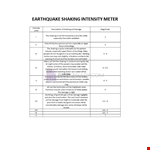When it comes to understanding earthquakes, one key aspect to consider is the earthquake intensity scale. The magnitude of an earthquake holds great significance in assessing its impact and potential devastation. But what exactly does the magnitude of an earthquake mean in relation to the intensity scale?
Specifically, the intensity scale used by Phivolcs (Philippine Institute of Volcanology and Seismology) plays a crucial role in measuring the intensity of earthquakes. It provides valuable insights into the level of shaking and potential damage caused by an earthquake.
Staying updated with the latest seismic activity is essential for those living in earthquake-prone regions. By keeping track of earthquake occurrences today, individuals can stay prepared and take necessary precautions to ensure their safety.
Understanding the difference between magnitude and intensity is vital. While magnitude refers to the energy released at the earthquake source, intensity focuses on the effects and level of shaking experienced at a particular location.
Earthquake intensity scales serve as a standardized way to measure and classify earthquakes based on their effects. They provide a clear framework for assessing the severity and impact of an earthquake event.
For those wondering about the strongest intensity scale, it varies depending on the specific scale used. However, common examples include the Modified Mercalli Intensity (MMI) scale and the European Macroseismic Scale (EMS).
